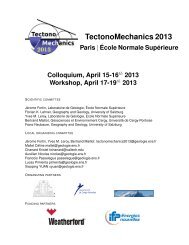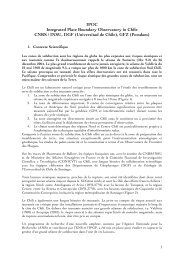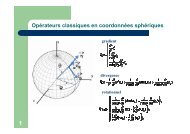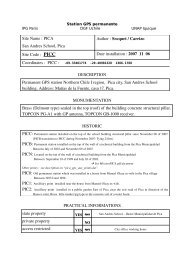PDF file - Laboratoire de Géologie de l'Ecole normale supérieure - Ens
PDF file - Laboratoire de Géologie de l'Ecole normale supérieure - Ens
PDF file - Laboratoire de Géologie de l'Ecole normale supérieure - Ens
Create successful ePaper yourself
Turn your PDF publications into a flip-book with our unique Google optimized e-Paper software.
JOURNAL OF GEOPHYSICAL RESEARCH, VOL ?, 2006, DOI<br />
25 years of geo<strong>de</strong>tic measurements along the Tadjoura-Asal<br />
rift system, Djibouti, East Africa.<br />
Christophe Vigny 1 , Jean-Bernard <strong>de</strong> Chabalier 2 , Jean-Clau<strong>de</strong> Ruegg 2 , Philippe Huchon 3 , Kurt L. Feigl 4 , Rodolphe<br />
Cattin 1 , Laike Asfaw 5 , Khaled Kanbari 6 .<br />
Abstract. Since most of Tadjoura-Asal rift system sits on dry land in the Afar <strong>de</strong>pression near the triple junction<br />
between the Arabia, Somalia and Nubia plates, it is an i<strong>de</strong>al natural laboratory for studying rifting processes. We<br />
analyze these processes in light of a time series of geo<strong>de</strong>tic measurements from 1978 through 2003. The surveys<br />
used triangulation (1973), trilateration (1973, 1979 and 1981 to 1986), leveling (1973, 1979, 1984-1985, and<br />
2000), and the Global Positioning System (GPS, in 1991, 1993, 1995, 1997, 1999, 2001 and 2003). A network of<br />
about 30 GPS sites covers the Republic of Djibouti. Additional points were also measured in Yemen and Ethiopia.<br />
Stations lying in the Danakil block have almost the same velocity than Arabian plate indicating that the opening of<br />
the Red Sea at its southern tip is almost totally accommodated in the Afar <strong>de</strong>pression. Insi<strong>de</strong> Djibouti, the Asal-<br />
Ghoubbet rift system accommodates 16±1 mm/yr of opening perpendicular to the rift axis, and exhibits a<br />
pronounced asymmetry with essentially null <strong>de</strong>formation on its southwestern si<strong>de</strong> and significant <strong>de</strong>formation on<br />
its northeastern si<strong>de</strong>. This rate, slightly higher than the large-scale Arabia-Somalia motion (13±1 mm/yr), suggests<br />
transient variations associated to the relaxing processes after the Asal-Ghoubbet seismo-volcanic sequence of<br />
1978. Insi<strong>de</strong> the rift, the <strong>de</strong>formation pattern exhibits clear 2-D pattern. Along the rift axis, the rate is <strong>de</strong>creasing to<br />
the northwest, suggesting propagation of the system in the same direction. Perpendicular to the rift axis, the<br />
localization of the opening is clearly shifted to the northeast, relatively to the topographic rift axis, in the “Petit<br />
Rift”, a rift-in-rift structure, where is concentrated most of the active faults and the present seismicity. Vertical<br />
motions (comparisons of leveling pro<strong>file</strong>s) also confirm this asymmetry, with a current bulge of the northeastern<br />
shoul<strong>de</strong>r. Finally, all sites insi<strong>de</strong> the rift system show varying vertical motions from 0 to 10 mm/yr, but always<br />
positive, indicating that although the internal floor is subsiding relative to the rift shoul<strong>de</strong>rs, the whole system is<br />
moving upward.<br />
Introduction<br />
The Afar <strong>de</strong>pression, at the triple junction between<br />
Arabia, Somalia, and Nubia, is actively <strong>de</strong>forming by<br />
continental stretching, rifting and volcanism. Here the<br />
three extensional structures of the Sheba Ridge, the<br />
Red Sea Ridge and the East African Rift join in a<br />
complicated geometry. Both the Red Sea Ridge and<br />
Sheba Ridge have been propagating for the last 30<br />
Myr, toward the south andwest, respectively. Yet they<br />
penetrate into the Afar <strong>de</strong>pression, rather than<br />
connecting directly through the Straits of Bab el<br />
Man<strong>de</strong>b. Consequently, the recent tectonic action<br />
there focuses around a set of disconnected, but<br />
. .<br />
1<br />
<strong>Laboratoire</strong> <strong>de</strong> <strong>Géologie</strong>, Ecole Normale Supérieure<br />
(ENS), CNRS, Paris, France<br />
2<br />
Institut <strong>de</strong> Physique du Globe (IPGP), Paris, France<br />
3<br />
<strong>Laboratoire</strong> <strong>de</strong> Tectonique, Université Pierre et Marie<br />
Curie-Paris6 & Institut Océanographique, Paris, France<br />
4<br />
Centre National <strong>de</strong> Recherche Scientifique (CNRS)<br />
Toulouse, France<br />
5<br />
Addis Observatory, Department of Geophysics, Addis<br />
Ababa University, Addis Ababa, Ethiopia<br />
6<br />
Department of Geosciences, University of Sana’a,<br />
Sana'a, Yemen<br />
1<br />
overlapping, propagating rift segments, that have<br />
created a complex network of normal faults (e.g.,<br />
Huchon et al. [1991]; Manighetti et al. [1997]). To<br />
better un<strong>de</strong>rstand the kinematics and the processes<br />
taking place in this area, we use geo<strong>de</strong>tic measurements<br />
which characterize the <strong>de</strong>formation at three scales<br />
<strong>de</strong>fined by different geophysical objects: the plates<br />
(distances ~ 1000 km), tectonic regions (between ~1000<br />
km and ~10 km), and rift segments (~10 km).<br />
At the scale of the plates, the existing long-term<br />
kinematic mo<strong>de</strong>ls disagree markedly. The conventional<br />
NUVEL-1A mo<strong>de</strong>l consi<strong>de</strong>rs Africa as a single plate to<br />
predict divergence between Africa and Arabia at a rate<br />
of about 16mm/yr and N28°E in azimuth at the southern<br />
tip of the Red-Sea [Demets et al., 1994]. Separating<br />
Africa into two plates, Somalia and Nubia, Jestin et al.<br />
[1994] propose a similar relative velocity: 17 mm/yr at<br />
azimuth N30°E. Yet the rate of Arabia-Somalia motion<br />
varies along the Sheba Ridge from 22 mm/yr at the horn<br />
of Africa to 17mm/yr at the entrance of the Gulf of<br />
Tadjoura [DeMets et al., 1994]. For the East African<br />
Rift (EAR), that splits Africa into Somalia and Nubia,<br />
estimates of the divergence rate also vary consi<strong>de</strong>rably:<br />
1 mm/yr [Asfaw et al., 1992], 5 mm/yr [Jestin et al.,<br />
1994], or 6 mm/yr [Chu and Gordon, 1999].<br />
In contrast, recent GPS measurements in this area<br />
clearly differ from plate kinematic predictions. Different






